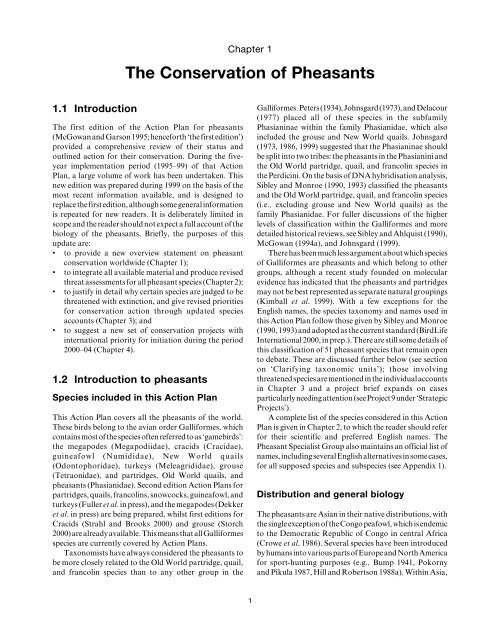Pheasants: Status Survey and Conservation Action Plan ... - IUCN
Pheasants: Status Survey and Conservation Action Plan ... - IUCN
Pheasants: Status Survey and Conservation Action Plan ... - IUCN
Create successful ePaper yourself
Turn your PDF publications into a flip-book with our unique Google optimized e-Paper software.
Chapter 1<br />
The <strong>Conservation</strong> of <strong>Pheasants</strong><br />
1.1 Introduction<br />
The first edition of the <strong>Action</strong> <strong>Plan</strong> for pheasants<br />
(McGowan <strong>and</strong> Garson 1995; henceforth ‘the first edition’)<br />
provided a comprehensive review of their status <strong>and</strong><br />
outlined action for their conservation. During the fiveyear<br />
implementation period (1995–99) of that <strong>Action</strong><br />
<strong>Plan</strong>, a large volume of work has been undertaken. This<br />
new edition was prepared during 1999 on the basis of the<br />
most recent information available, <strong>and</strong> is designed to<br />
replace the first edition, although some general information<br />
is repeated for new readers. It is deliberately limited in<br />
scope <strong>and</strong> the reader should not expect a full account of the<br />
biology of the pheasants. Briefly, the purposes of this<br />
update are:<br />
• to provide a new overview statement on pheasant<br />
conservation worldwide (Chapter 1);<br />
• to integrate all available material <strong>and</strong> produce revised<br />
threat assessments for all pheasant species (Chapter 2);<br />
• to justify in detail why certain species are judged to be<br />
threatened with extinction, <strong>and</strong> give revised priorities<br />
for conservation action through updated species<br />
accounts (Chapter 3); <strong>and</strong><br />
• to suggest a new set of conservation projects with<br />
international priority for initiation during the period<br />
2000–04 (Chapter 4).<br />
1.2 Introduction to pheasants<br />
Species included in this <strong>Action</strong> <strong>Plan</strong><br />
This <strong>Action</strong> <strong>Plan</strong> covers all the pheasants of the world.<br />
These birds belong to the avian order Galliformes, which<br />
contains most of the species often referred to as ‘gamebirds’:<br />
the megapodes (Megapodiidae), cracids (Cracidae),<br />
guineafowl (Numididae), New World quails<br />
(Odontophoridae), turkeys (Meleagrididae), grouse<br />
(Tetraonidae), <strong>and</strong> partridges, Old World quails, <strong>and</strong><br />
pheasants (Phasianidae). Second edition <strong>Action</strong> <strong>Plan</strong>s for<br />
partridges, quails, francolins, snowcocks, guineafowl, <strong>and</strong><br />
turkeys (Fuller et al. in press), <strong>and</strong> the megapodes (Dekker<br />
et al. in press) are being prepared, whilst first editions for<br />
Cracids (Strahl <strong>and</strong> Brooks 2000) <strong>and</strong> grouse (Storch<br />
2000) are already available. This means that all Galliformes<br />
species are currently covered by <strong>Action</strong> <strong>Plan</strong>s.<br />
Taxonomists have always considered the pheasants to<br />
be more closely related to the Old World partridge, quail,<br />
<strong>and</strong> francolin species than to any other group in the<br />
Galliformes. Peters (1934), Johnsgard (1973), <strong>and</strong> Delacour<br />
(1977) placed all of these species in the subfamily<br />
Phasianinae within the family Phasianidae, which also<br />
included the grouse <strong>and</strong> New World quails. Johnsgard<br />
(1973, 1986, 1999) suggested that the Phasianinae should<br />
be split into two tribes: the pheasants in the Phasianini <strong>and</strong><br />
the Old World partridge, quail, <strong>and</strong> francolin species in<br />
the Perdicini. On the basis of DNA hybridisation analysis,<br />
Sibley <strong>and</strong> Monroe (1990, 1993) classified the pheasants<br />
<strong>and</strong> the Old World partridge, quail, <strong>and</strong> francolin species<br />
(i.e., excluding grouse <strong>and</strong> New World quails) as the<br />
family Phasianidae. For fuller discussions of the higher<br />
levels of classification within the Galliformes <strong>and</strong> more<br />
detailed historical reviews, see Sibley <strong>and</strong> Ahlquist (1990),<br />
McGowan (1994a), <strong>and</strong> Johnsgard (1999).<br />
There has been much less argument about which species<br />
of Galliformes are pheasants <strong>and</strong> which belong to other<br />
groups, although a recent study founded on molecular<br />
evidence has indicated that the pheasants <strong>and</strong> partridges<br />
may not be best represented as separate natural groupings<br />
(Kimball et al. 1999). With a few exceptions for the<br />
English names, the species taxonomy <strong>and</strong> names used in<br />
this <strong>Action</strong> <strong>Plan</strong> follow those given by Sibley <strong>and</strong> Monroe<br />
(1990, 1993) <strong>and</strong> adopted as the current st<strong>and</strong>ard (BirdLife<br />
International 2000, in prep.). There are still some details of<br />
this classification of 51 pheasant species that remain open<br />
to debate. These are discussed further below (see section<br />
on ‘Clarifying taxonomic units’); those involving<br />
threatened species are mentioned in the individual accounts<br />
in Chapter 3 <strong>and</strong> a project brief exp<strong>and</strong>s on cases<br />
particularly needing attention (see Project 9 under ‘Strategic<br />
Projects’).<br />
A complete list of the species considered in this <strong>Action</strong><br />
<strong>Plan</strong> is given in Chapter 2, to which the reader should refer<br />
for their scientific <strong>and</strong> preferred English names. The<br />
Pheasant Specialist Group also maintains an official list of<br />
names, including several English alternatives in some cases,<br />
for all supposed species <strong>and</strong> subspecies (see Appendix 1).<br />
Distribution <strong>and</strong> general biology<br />
The pheasants are Asian in their native distributions, with<br />
the single exception of the Congo peafowl, which is endemic<br />
to the Democratic Republic of Congo in central Africa<br />
(Crowe et al. 1986). Several species have been introduced<br />
by humans into various parts of Europe <strong>and</strong> North America<br />
for sport-hunting purposes (e.g., Bump 1941, Pokorny<br />
<strong>and</strong> Pikula 1987, Hill <strong>and</strong> Robertson 1988a). Within Asia,<br />
1
















